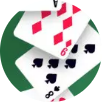Important for laypersons
Injured by a knife: the best way to help
How long has it been since your last first aid course? Would you have known how best to help the victims of the attack in Villach as a layperson? What to do in the event of knife injuries? We asked the Vienna Professional Rescue Service for clarification!
Knives are tools that are quickly at hand. As a result, they can also quickly become weapons, as brutal attacks throughout Austria - and most recently in Villach (Carinthia) - show time and again. Imagine you are out and about, perhaps shopping, and then come across such an attack, visibly injured people lying on the ground. What should you do?
"The most important thing is your own safety," emphasizes Dr. Daniel Grassmann, senior physician at the Vienna Professional Rescue Service: "As much as you want to help, you have to be sure that there is no danger to yourself before you approach."
For example, if you have witnessed an altercation, "first make sure that the attacker has moved away". Only when you are sure that there is no danger should you approach the injured person.
The most important thing is your own safety! As much as you want to help - before you approach, you must be sure that there is no danger to yourself.

Oberarzt Dr. Daniel Grassmann, Berufsrettung Wien
Bild: Markus Hechenberger
So how do you recognize which injuries are involved, whether the weapon was a knife? "Typical indications of an injury with a sharp object are visible stab wounds or cuts, heavy bleeding or pools of blood near the injured person," explains Grassmann.
Of course, a knife lying around or other traces of an attack could also indicate this. "Other indications are expressions of pain on the part of the person concerned or a recognizably poor general condition."
Harmless or not
When are knife wounds actually particularly dangerous? "Injuries with sharp or pointed objects are particularly life-threatening if large blood vessels are injured," says Grassmann, "as life-threatening blood loss can occur within a very short time."
Internal organs such as the heart, lungs, liver or spleen are also particularly at risk: "Blood can leak into the surrounding body cavity without being immediately recognizable from the outside".
Even seemingly harmless puncture wounds can be dangerous, as the expert warns: "A seemingly minor puncture can cause internal injuries that initially go unnoticed but can become life-threatening within a few minutes. Therefore, every puncture wound, no matter how small it may seem, should be taken seriously."
Don't be afraid to get help
Grassmann can reassure anyone who is reluctant to act out of uncertainty or fear of doing something wrong: "As long as the area is safe, there is hardly anything a first aider can do wrong. Quite the opposite - first aid for this type of injury, especially acute bleeding, can be life-saving!"
Of course, it depends on the individual case, but we have listed the most important steps to follow in such situations below:
- Make an emergency call
"Once it has been established that there is no danger, the emergency call must be made immediately: Rescue 144, police 133," says Grassmann.
As long as the area is safe, first aiders can hardly do anything wrong. On the contrary - first aid for this type of injury, especially acute bleeding, can be life-saving!

Oberarzt Dr. Daniel Grassmann, Berufsrettung Wien
Bild: Markus Hechenberger
- Stop heavy bleeding
If there is heavy, active bleeding, such as a spurting wound on the thigh, you must try to stop it "immediately by applying direct pressure to the wound or with a pressure bandage".
- Check condition
"You then check whether the person is responsive," says the senior physician. This is done in a loud voice. "Additional gentle shaking of the shoulders is used to test whether the person is responding adequately," explains Grassmann. If this is not the case, breathing must be checked immediately. - Unconscious or not
--> If the person is unconscious but breathing normally, they are placed in the recovery position," says the doctor. If they are not breathing, chest compressions must be started immediately.
--> "If the person is conscious, they should be reassured and placed in as comfortable a position as possible."
- Treat further injuries
The person should then be checked for further injuries. "Wounds to the chest and abdomen should be covered with a sterile cloth if available." - What to do with knives and foreign objects
Very important: "If a knife or other foreign object is stuck in a wound, it must not be removed under any circumstances!" emphasizes Grassmann: "Instead, the foreign object should be held in place with compresses or cloths to prevent movement and thus further injury." If possible, the injured person should "not move at all, as this can aggravate internal injuries".
- Involve others
"If other first aiders are on site, they should always be involved," says the senior physician. Police officers are trained in first aid, "and there are also police paramedics who can provide advanced professional care".
- Telephone helpers
There are dispatchers on the 144 emergency call line "who will guide you through the situation on the phone and help you with the first aid measures", says Grassmann: "There are precise instructions on how to treat a bleeding wound or give chest compressions."
- Help for yourself
If you "can't let go of the whole thing mentally and it becomes an emotional burden, it's important to talk about it", the doctor appeals: "It's completely normal for such an exceptional situation to leave its mark on you." Psychological support should therefore be sought without hesitation: "Just as it is important to help others, you should also take care of your own well-being."
In a nutshell
- Berufsrettung Wien (Municipal Department 70) provides the majority of all ambulances used in Vienna, operates the control centre and dispatching and works together with private aid organizations.
- The Vienna Rescue Academy is exclusively responsible for the first aid training of employees of the City of Vienna.
- Aid organizations such as the following offer first aid courses for everyone: Samariterbund, Johanniter Unfallhilfe, Red Cross, Malteser Hospitaldienst
How you can prepare yourself
As you can see, we should all be interested in regularly refreshing our first aid skills.
This article has been automatically translated,
read the original article here.













Kommentare
Liebe Leserin, lieber Leser,
die Kommentarfunktion steht Ihnen ab 6 Uhr wieder wie gewohnt zur Verfügung.
Mit freundlichen Grüßen
das krone.at-Team
User-Beiträge geben nicht notwendigerweise die Meinung des Betreibers/der Redaktion bzw. von Krone Multimedia (KMM) wieder. In diesem Sinne distanziert sich die Redaktion/der Betreiber von den Inhalten in diesem Diskussionsforum. KMM behält sich insbesondere vor, gegen geltendes Recht verstoßende, den guten Sitten oder der Netiquette widersprechende bzw. dem Ansehen von KMM zuwiderlaufende Beiträge zu löschen, diesbezüglichen Schadenersatz gegenüber dem betreffenden User geltend zu machen, die Nutzer-Daten zu Zwecken der Rechtsverfolgung zu verwenden und strafrechtlich relevante Beiträge zur Anzeige zu bringen (siehe auch AGB). Hier können Sie das Community-Team via unserer Melde- und Abhilfestelle kontaktieren.